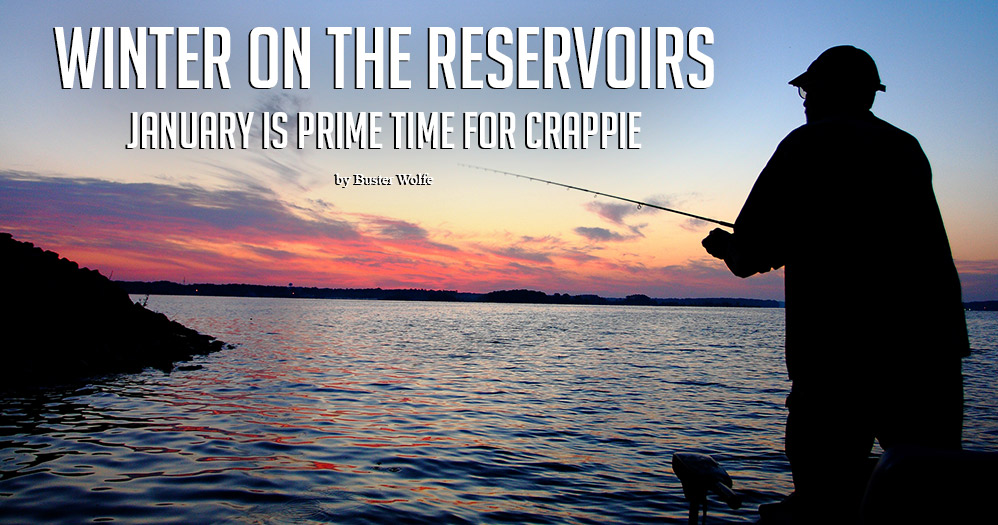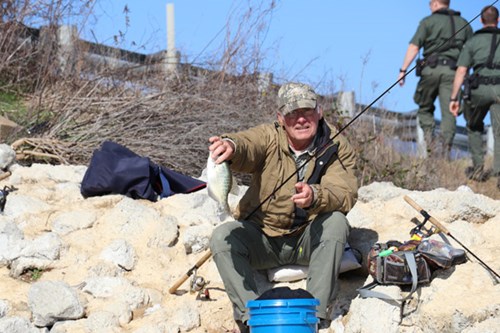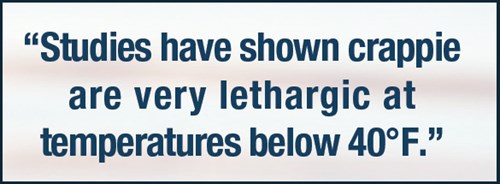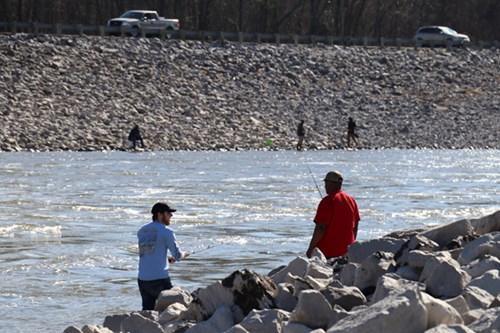Mississippi Outdoors: Winter on the Reservoirs
1/17/2018 11:39:28 AM
By Buster Wolfe

Plenty of outdoors action is in the spotlight as the new year begins in Mississippi, with hunting for ducks and deer in full swing. And the promise of warmer weather turns a sportsman’s fancy toward thoughts of turkey season and big fish.
However, January is also a prime time in certain areas of the state for some big-time crappie fishing. In order to prepare for the upcoming spring spawning season, fish begin the feeding frenzy to gain weight and work on their stamina.
Prime fishing areas are the state’s five major reservoirs: four in the northern part (considered the top crappie destinations anywhere) and the state’s Capital City waterbody. For northern Mississippi, crappie are spotlighted at Arkabutla, Grenada, Enid, and Sardis reservoirs, while Ross Barnett Reservoir takes center stage for early year crappie fishing.
Keith Meals, a Mississippi Department of Wildlife, Fisheries, and Parks (MDWFP) biologist who works in north Mississippi with the U.S. Army Corps of Engineers-run reservoirs, said the movement of crappie in the flood control reservoirs is determined by the water temperature.
“Studies have shown crappie are very lethargic at temperatures below 40 (degrees Fahrenheit),” he said. “They are only active in winter when it is unusually warm, like last winter or the 2011–2012 winter.”

Each northern Mississippi reservoir has its own unique characteristics, but all hold monster crappie. At the four flood-control reservoirs, each fishing site has gates to lower or raise water levels according to need.
Arkabutla Reservoir, which is close to Memphis, includes 57,250 total acres of land and water with a dam that is 11,500 feet long with an average height of 67 feet. Sardis, Enid, and Grenada reservoirs are part of what is called the “Arc of Slabs” because of their close proximity (all are located along Interstate 55).
For water levels, the Corps of Engineers relies on historical seasonal rainfall patterns to set the January winter pool, Meals said.
“The U.S. Army Corps of Engineers, Vicksburg District, uses rule curves … to minimize flooding in the agriculturally important Delta region,” he said. “Reservoir levels are raised by rainfall runoff; there is no upstream spigot, but there is a downstream drain. Moveable steel gates allow excess water to flow through two to four tunnels through each dam into reservoir spillways.”
Like most natural ebbs and flows, Mother Nature can throw a curveball some years that will affect water levels.
“Droughts and floods result in deviations from the rule curve,” Meals said. “The southern three reservoirs—Sardis, Enid, Grenada—begin a very slow rise January 15 from winter pool to five feet above winter pool by March 1. Arkabutla is managed differently due to its small storage capacity and large watershed. In reality, they rise from rainfall events and are drawn back down to rule curve all winter.”
While all of this rising and lowering is going on, some smaller crappie die off from the release of a lot of bitterly cold water from the reservoirs to the spillways, Meals said.
“Moderate releases at normal winter temperatures primarily result in losses of small (young-of-year) crappie,” he said. “MDWFP conducted a study of winter crappie loss at Enid reservoir from the reservoirs from 1992–1994. It was found that losses were not a large proportion of the population; losses of large numbers of adult fish that concerned anglers were rare events under normal water levels. The reservoirs have high rates of natural crappie reproduction most years; spillway losses of young-of-year crappie are normally beneficial to reduce numbers and increase growth rates of remaining fish.”
With fewer smaller fish to bulk up for spawning, the larger crappie are prime targets for the early season.
“A winter with low releases, either from drought or flood, may result in retaining large numbers of young-of-year in the reservoirs,” said Meals, referring to the times when little water can be released without property damage. “Although these conditions can create big-year classes, our investigations show these big-year classes grow slower than normal. The big crappie that the reservoirs are famous for are made possible by the fast growth rates these water level manipulations create.”
So while the dams offer the deepest areas for holding fish, crappie are not always lingering near the spillways.

“If winter water temperatures are normal, crappie tend to avoid the dams and hold over bottom features,” Meals said, referring to places like old river channels and ledges. “Most of the winter, water temperatures are pretty much the same top to bottom but may warm up in the upper few feet with warm, sunny weather. If winter water levels are normal (which is low), crappie can be extremely concentrated in a few key areas that may be fished regularly by many boats for months, potentially resulting in depletion of legal fish by the time ‘crappie season’ rolls around.”
Meals said the popularity of the flood-control reservoirs for crappie fishing is based on being able to target the fish in certain areas based on the water level all year.
“High or rapidly fluctuating, cold, muddy water makes fishing challenging,” he said. “Success increases with the opposite conditions. Historically, crappie fishing on the reservoirs peaked in spring and fall. The growing popularity of trolling, coupled with the advent of more sophisticated electronics—such as GPS, side-scan, and 360-depth finders—has made it much more a year-round pursuit.”
Meals said while crankbaits are warm-weather lures, winter fishing is more successful with jigs and/or minnows using slower presentations than in warmer water.
“Although many anglers downsize lures in cold water, using larger minnows results in less by-catch of short crappie,” he said. “Crappie depth in winter is highly dependent on both water level and temperature. If water levels are high and/or cold, fish usually hold deeper and vice versa; often fish move up in the water column as the water warms on a sunny day. If it is warm enough that crappie are actively feeding, they will hold near schools of baitfish, like shad.”
At Ross Barnett Reservoir, MDWFP biologist Ryan Jones said the shorter days in December and January tell the fish that spawning is around the corner and feeding is in order.

“Crappie begin feeding in an effort to increase gonadal growth and improve spawning potential,” he said, adding that the fish will seek out deeper water away from the dam. “Crappie can be caught in deep river channels or old lakes during this time of year by fishing minnows or trolling small crankbaits and roadrunners.”
Like summer fishing, baitfish are the key to success, Jones said.
“The first objective is to find the shad and concentrate your attention on that depth,” he said.
“This will typically be between 15 and 20 feet deep. The summer pattern is very similar as the fish will also be found deep at that time. As the water warms up and the spawn approaches, crappie begin to move up in the water column until they find their way to the shallows.”
Meals said the success of each reservoir is based mainly on weather and water conditions.
“They can all be either good or bad that time of year,” he said. “Although some anglers only fish on ‘their’ lake, crappie websites, social media, and guide services have resulted in a mobile pool of anglers that find out where the fish are biting and concentrate on that spot until their catch rates decline, and then move to the next hot spot.”
Finding a hotspot is a good thing, but bragging about it can bring you plenty of company.
“Anglers that have bragged and/or posted pictures of big catches on social media about a specific reservoir have found out they get more company than they wanted,” Meals said. “Most have now wised up and either avoid telling where their fish were caught or ‘misdirect’ other anglers away from ‘their’ lake.”
Buster Wolfe is a freelance writer for Mississippi Outdoors.









